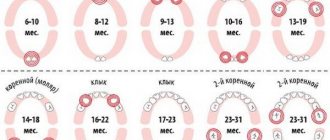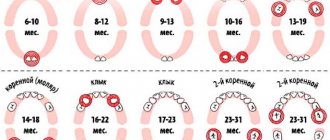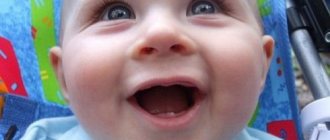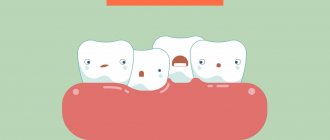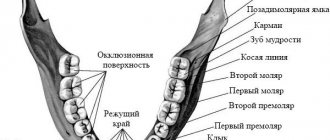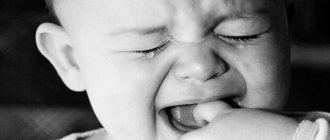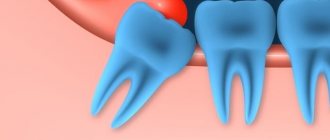This is important: if a pregnant woman has a calcium deficiency, it must be replenished. The baby’s health, and, in particular, the health and strength of his teeth, depends on this. But even an experienced pediatric dentist will not be able to accurately predict which tooth will begin to erupt first. Usually, however, the front ones appear: lower or upper incisors. And this happens within a period of 3 to 8 months. But there have been cases when babies were already born with teeth. And for others, the first tooth appeared only at 1.5 years. And this is also considered the norm.
Description and symptoms of the problem
The germ of a retention tooth is located in the bone, but its further growth does not occur for a number of specific reasons. This phenomenon is considered anomalous if the element has not erupted within two years from the due date.
In the partial form of the pathology, part of the crown is located above the gum or its outline is visible through the gum tissue. With complete retention, both the crown and root remain completely hidden. Typically, this problem affects the incisors, canines and the outermost “eights”. To clarify the position and shape, an x-ray examination is often required.
Typically, patients note an increase in body temperature and general malaise during teething, swelling and a change in the shade of the mucous membrane. In addition, if the element is fully formed in the bone tissue, but does not appear on the surface, pronounced pain may occur (most often it is monotonous). This indicates that the tooth is pressing on the roots of its neighbors. In some situations, facial numbness is also noted, which is caused by pressure on the nerve endings. It is also worth noting that in some cases the pathology does not provoke the appearance of any obvious symptoms.
What affects the timing of teeth appearance?
Each child goes through his own developmental path. There are no standards here. Several factors influence teething:
- Heredity. If your baby's teeth are growing poorly and slowly, perhaps his mom and dad had the same thing. There is no need to worry here.
- The course of pregnancy and intrauterine development. It is known that the rudiments of baby teeth are formed in the seventh week of pregnancy, and permanent teeth in the fifth month.
- Child nutrition. The baby's complementary foods should be rich in minerals, including calcium. Poor and unbalanced nutrition worsens this process.
Dentists advise: to strengthen gums and grow children's teeth, vitamins are needed (the main ones are A and D). They are found in sufficient quantities in fermented milk products, vegetables and fruits.
- Past illnesses. Rickets, especially severe forms, hypofunction of the thyroid gland, exudative diathesis and other diseases affect delayed teething.
- Natural factors (proximity to nuclear test sites, fluoride pollution of the environment and much more).
- Dental anomalies.
Pediatric dentistry specialists have nevertheless drawn up a diagram of the growth of incisors, canines and molars, although the sequence of their appearance and timing are approximate:
- 6-10 months – upper central incisors;
- 8-12 months – lower central incisors;
- 10-16 months – lateral incisors;
- 1.5-2 years – fangs;
- 1-1.5 years – first molars;
- after 2 years – second molars.
Take note: to prevent the baby tooth from interfering with the growth of the permanent one, you can ask the child to pull it out himself. If it's already very wobbly, it won't hurt. And replacing a tooth hidden under a pillow with candy will be a joyful surprise for the baby.
The change to permanent teeth begins at the age of 5-7 years. First the incisors fall out, then the fangs. The matter is completed by replacing the first and second molars from the center.
Reasons for retention
Most often, the reason for the development of retention is associated with the incorrect location of neighboring teeth, which become an obstacle to the eruption of retention teeth. In other cases, the problem may be due to too dense bone or gum tissue.
Other factors influencing the development of pathology include the following phenomena:
- supernumerary (abnormally large number of teeth),
- diseases of internal organs, which leads to disruption of the full development of the entire skeletal system,
- loss of baby teeth at too early an age,
- genetic predisposition.
Delayed eruption of primary teeth in children
Delayed eruption of primary teeth in infants and children under one year of age is called retention. Most often this occurs with canines, but sometimes affects incisors and molars. It’s not scary if the age at which the first teeth appear does not coincide with the “template” age. There are the following reasons for late eruption:
- gender of the child;
- climate zone;
- Congenital heart defect;
- genetic predisposition;
- compliance with hygiene rules;
- maternal health during pregnancy.
A delay of 1–2 months is considered normal, but a longer delay is evidence of pathology. As a rule, late appearance of dentition can be the result of diseases suffered by the mother during pregnancy, or diseases of the baby itself. In addition, so-called supernumerary (excess) teeth can hinder timely eruption. At the same time, too early the appearance of a baby tooth in a child may indicate a disorder of the body’s endocrine system.
Important!
If you notice a violation of the order of eruption of baby teeth, contact your pediatrician and pediatric dentist.
When can I expect my baby's permanent teeth to appear?
When the eruption of baby teeth ends, parents feel relieved and forget that this is only the first stage of the formation of the dentition. Be prepared that after a while you will have to help your baby transfer the change of baby teeth to molars.
Thanks to a certain order of eruption of molars, children develop a correct bite. The first teeth to appear are the incisors, which occurs around 6–7 years of age. Then comes the turn of the canines and premolars. The last teeth to be replaced in children are molars. In the case of permanent teeth, the principle of paired appearance also remains. The entire dentition is replaced by adulthood, but wisdom teeth may appear much later.
The symptoms of baby and permanent tooth eruption are very different. The appearance of molars is not accompanied by vomiting, sleep disturbances, loss of appetite and other signs, but a slight increase in temperature or itching of the gums is possible.
Photo of baby teeth erupting
Malocclusion in a child: identify and correct it in time!
Normal or pathological bite?
If the teeth in the lateral section close so that each upper tooth falls between the two lower ones (this position of the teeth is also compared to a caterpillar tractor), and the upper front teeth overlap the lower ones by one third, then such a bite can be called normal, even standard.
And doctors call it orthognathic. Variants of the norm also include the correct closure of the lateral surfaces, but at the same time a slight rotation or rotation of one of the teeth, as well as small gaps (diastemas) between the teeth. Also within normal limits, there may be slight crowding of the teeth in the lower jaw.
Now let's talk about bite pathologies... These include distal bite, when the upper jaw is strongly pushed forward relative to the lower jaw. Such a bite may be associated with underdevelopment of the lower jaw with a normally developed upper jaw or, conversely, with an overdeveloped upper jaw against the background of normal development of the lower jaw. A similar bite pathology can occur due to congenital (hereditary) underdevelopment of the jaws, as well as due to impaired nasal breathing or due to a number of pathologies of other body systems. For example, due to difficulty in nasal breathing, a child has to breathe through his mouth, as a result of which the cheek muscles are in a tense state, which prevents the development of the lower jaw. Also, the formation of a pathological distal bite is promoted by throwing back the child’s head during sleep. Recession of the lower jaw in this position of the head leads to its underdevelopment. The problem of distal occlusion arises and is identified in childhood, when the formation and growth of the body as a whole occurs.
Mesial bite is most often the result of a skeletal abnormality, that is, a problem in the structure of the lower jaw. This is mainly a hereditary form of malocclusion. Since the lower jaw is overdeveloped, it is pushed forward in relation to the upper. Those with this type of bite are characterized by a large, so-called archaic chin. This malocclusion pathology is most often treated surgically: a resection (removal of part) of the jaw is performed, and only then the position of the teeth is corrected with the help of braces.
Another type of bite pathology is an open bite, when the teeth in the lateral regions close together, but not in the front. This type of bite develops as a result of bad habits - prolonged nipple sucking (up to 4-5, and sometimes 6 years), thumb sucking, and also in children who chew pencils. You may ask, where do bad habits in children come from? Let's figure it out. As we know, breastfeeding is of great importance in the formation of the bite. A child is born with a distal bite, when the lower jaw is slightly behind, and this is the norm for a newborn. It is this position of the jaws that allows the baby to simultaneously swallow milk and breathe. When a baby suckles at the breast, he is forced to make certain muscular efforts and move his jaw forward. This stimulates the growth and development of the lower jaw. If breastfeeding is not available, the baby is bottle-fed. Often, mothers make too large holes in the nipple in order to “facilitate” the sucking process for the baby, and the milk actually pours into the mouth itself - the baby no longer needs to make any effort during the sucking process. The result is that the lower jaw does not develop. When the baby switches to regular food, he compensates for the sucking stage by sucking fingers, pacifiers, etc. The second important factor in the formation of bad habits is difficult nasal breathing, in which the child is forced to constantly keep his mouth open. Try sitting for a long time with your mouth open. Even for an adult whose facial muscles are well developed, this is quite difficult. Trying to alleviate the situation, the child puts a finger or a pencil in his mouth so that the muscles relax. After all, “leaning” on a pencil, he can calmly breathe through his mouth for a long time.
Therefore, parents should understand how important it is to avoid the formation of bad habits: they need to choose orthodontic nipples with the required number and diameter of holes (they can be bought at almost any large pharmacy) and “force” the baby to suck correctly, as well as resolve problems that impede the child’s free nasal breathing depending on the reasons creating these problems. Believe me, the formation of a child’s correct bite largely depends on the mother.
However, if the baby has already become the owner of one or more bad habits, then this can be treated quite successfully: at the age of 5–6 years, the nipples are replaced with special plates with flaps and grilles for the tongue, which allow you to quickly correct an open bite.
In a deep bite, the upper jaw overlaps too much with the lower jaw. The reasons for the development of a deep bite are mainly underdevelopment of the lower jaw, skeletal forms of anomaly, or such a bite can be caused by a certain position of the teeth. This bite is considered traumatic, since when chewing, the lower incisors hit the upper palate. As a result, traumatic gingivitis develops.
Crossbite is another type of pathological bite that occurs mainly in the lateral parts of the jaw. Outwardly, it looks like a shift of the chin to one side or the other. Crossbite can develop as a result of jaw injury, underdevelopment of the lateral parts of the lower jaw, as well as a bad habit - when a child sleeps or sits with his cheek propped up with his fist (at the age of 5–6 years). Moreover, in an adult, such a bad habit has no effect on an already formed bite.
Meeting an orthodontist
It is necessary to visit a pediatric orthodontist for the first time at the age of 3.5–4 years, when preparations are underway for the formation of a permanent bite. At this age, distal and medial bites can be diagnosed. If necessary, treatment will be prescribed: wearing plates or caps. At the same time, you cannot yet determine a deep bite, since it is the norm during this period.
The rudiments of permanent teeth begin to form while the baby is in the womb, and this process continues in the first years of life. The baby teeth are close to each other, but at the age of 3.5 years, as the jaws grow, gaps between the teeth (diastema) begin to appear, and by the age of 6 they can reach the distance of one baby tooth. This is due to the fact that the buds of permanent teeth and the permanent teeth themselves are larger than milk teeth. Therefore, this is a normal process that should not cause any concern to parents.
In addition, parents are often frightened by the “disproportionately” large erupted permanent incisors. However, this is normal, because the jaw will grow, and over time, the once “too large” teeth will become absolutely normal, that is, proportional to the size of the jaws.
If the doctor does not reveal any violations, then the next visit should take place at 6–7 years of age - during the period of replacement of milk teeth with permanent ones. First, the “sixes” erupt (by the way, there are no 6 primary teeth) and the incisors are replaced. At this age, it will be clear whether there is enough space for all the other teeth. If not, then at this stage you should begin orthodontic treatment - wearing mouth guards or plates. The purpose of the plates in this case is to stimulate jaw growth and straighten teeth. Mouth guards are designed to correct the bite, widen the jaw, and eliminate bad habits.
If at the age of 6–7 years no malocclusion was detected, then the next visit to the orthodontist is necessary at 10 years. At this age, the distant – 4th and 5th – chewing teeth, as well as canines, begin to change. And it is the fangs that may not have enough space in the row. This problem can be solved by using plates or partial braces on the front four teeth.
It is also necessary to be observed by an orthodontist during the period of eruption of “eights” (the so-called wisdom teeth) - at about 16-17 years old, but now there is a tendency towards earlier eruption of 8 teeth (at 15 years). They can greatly affect your bite. If there is not enough space for the insidious “eights” to erupt, this can lead to crowding of teeth, often to an even greater extent than before. And then wearing braces cannot be avoided. In cases where wisdom teeth have not erupted, it is necessary to take an x-ray, which will help determine how much their rudiments will affect the bite. If there is not enough space in the jaw and the “eights” begin to put pressure on the 7th teeth, then all four rudiments of the 8th teeth will most likely have to be removed. And such removals have a fairly high percentage - approximately 80 out of 100 cases, especially if the teeth are large.
Bite correction
To correct the bite in childhood, plates and mouth guards are mainly used - that is, removable structures. From 6 to 12 years of age, if necessary, children wear plates that, by putting pressure on the growth zones, stimulate the jaws and allow them to develop correctly. Of course, it is not necessary to wear the plates all the time: for example, after 1–1.5 years of correction, a break is taken (and at the time of changing teeth, they are removed without fail). As the jaws grow, the plates change. And the sooner we begin to correct the bite, the shorter the periods of wearing the plates and the faster the desired result is achieved.
Since the plates are removable structures, it is very important that the child does not forget to put them on. And if the baby does not want or forgets to wear the plates, then the responsibility for following medical recommendations falls on the parents. You need to wear the plates at least 12 hours a day, maximum 16, mostly at night and several hours during the day, and remove them while eating and playing sports. Actually, the longer the child wears the plate during the day, the faster the correction process occurs.
As practice shows, if a child tolerates the plates well, then at a later age he no longer returns to the orthodontist and avoids longer bite correction with the help of braces and the subsequent long-term (and sometimes lifelong) wearing of retainers (retaining arches, caps). , records).
If we are talking about bite correction at 12–14 years old, then braces are used. At this age, the period of wearing braces depends on the pathology of the bite and its severity. However, in adolescents, correction usually occurs faster: it is enough to wear braces for a year (in adults – 1.5–2 years). During the retention (or holding) period at this age, an arch is not placed, as in adults, but removable structures are used - plates or mouthguards (it is easier to maintain hygiene with them), which must be worn at night. On average, after 2 years, the retention period ends (in adults it takes 2 years or more).
Contraindications for orthodontic treatment
Orthodontic treatment for children with mental illness, organic diseases of the central nervous system (for example, with cerebral palsy), oncology and any other serious diseases of any organs and systems of the body is not carried out.
Relative contraindications may include periodontitis and grade 2–3 tooth mobility. And, of course, in pediatric orthodontics we often have to deal with the problem of poor oral hygiene. Moreover, if with children, say, up to 12–13 years old, parents cope and are able to control the timely brushing of their teeth, then with teenagers this situation most often gets out of control. If a teenager does not take care of his hygiene, then wearing, for example, braces leads to the rapid development of caries. In these cases, we advise you to “outgrow” a difficult age - after all, you can start correcting your bite at any time when a person has motivation and responsibility.
Individual characteristics
The average time for the appearance of the first baby tooth is 6 months, but teeth can begin to erupt at three months or a year, and both options are normal. If the child’s teeth do not appear, but there are no other complaints and the pediatrician does not notice any problems, then there is no need to worry until the child is a year or more old.
The same applies to the late beginning of the change of milk teeth to permanent ones. For some children, permanent incisors begin to appear already in the senior group of kindergarten, while others experience this moment at school. The normal period for the formation of a permanent bite is from 7 to 13 years.
Later than the average period, teeth may erupt in weakened, often ill children.
What to do?
Monitor other complaints, contact doctors if necessary, and if there are no complaints, then nothing. You cannot influence the rate at which teeth appear.
Completely edentulous
This is a rare phenomenon - the complete absence of tooth buds (deciduous or permanent). In this case, teeth cannot erupt because they are simply not in the jaw bone.
Complete edentia in the picture
In medicine, cases have been described when a patient had milk teeth, but permanent teeth were completely absent. The loss of baby teeth was timely, but permanent teeth did not appear in return. At this moment, the child’s parents paid attention to the problem, and the dentist made a diagnosis.
In addition to congenital, adentia can be acquired if the child has undergone severe treatment (chemotherapy) at an early age. Due to the toxic effects of drugs, tooth buds may be damaged.
What to do?
Edentia is clearly visible on a CT image. If such a diagnosis is made, the only option is complete prosthetics. Since the case is rare, the question of when to get dentures and in what way should be decided individually.
If you do not replace missing teeth with prosthetics, the chewing process cannot be complete. Even the lack of 2-3 teeth affects digestion. Bone tissue, if the jaws do not receive enough load when chewing, undergoes resorption (resorption), and this leads to weakening and loosening of the remaining teeth, increasing the risk of periodontal disease.
Therefore, if you have any complaints about your child’s teething being too slow, you should consult a doctor. In most cases, it turns out that there is no pathology, all teeth are fine and will grow a little later. But in rare cases, prosthetics may be required, which is better to know in advance. Then you can schedule treatment on time.
Other articles:
If a child does not want to be treated by an orthodontist...
When should your child see an orthodontist?
How to help your child not be afraid of dentists
How to make teething easier for your baby?
There are several ways to provide relief during teething in children. You can give your child something to chew, this will relieve pressure on the gums. Chilled water in a bottle, cool puree or yogurt can be life-saving remedies. Dental gel is often used to relieve teething pain in infants. Its application gives a temporary effect - the baby’s gums calm down for about twenty minutes. It is important not to use this remedy more than 6 times a day. The use of paracetamol under the age of 3 years without a doctor's recommendation is undesirable.
The main thing is not to confuse the appearance of teeth with symptoms of infectious diseases. Clinical manifestations of the eruption of primary teeth are:
- inflammation of the gums;
- increased salivation;
- decreased appetite;
- fast fatiguability;
- vomit;
- diarrhea;
- disturbing dream.
The eruption of the last baby teeth is easier and is practically not accompanied by pain.
Due to the structural features of primary teeth, up to 80% of pathologies, such as pulpitis, periodontitis and periostitis, develop precisely during the formation of primary occlusion. Therefore, you need to properly maintain your baby’s oral hygiene and monitor the condition of baby teeth. An alarming sign of teething may be teeth grinding or bleeding gums. Remember, dear parents, that your child’s good baby teeth today are the foundation for healthy permanent teeth for life.

